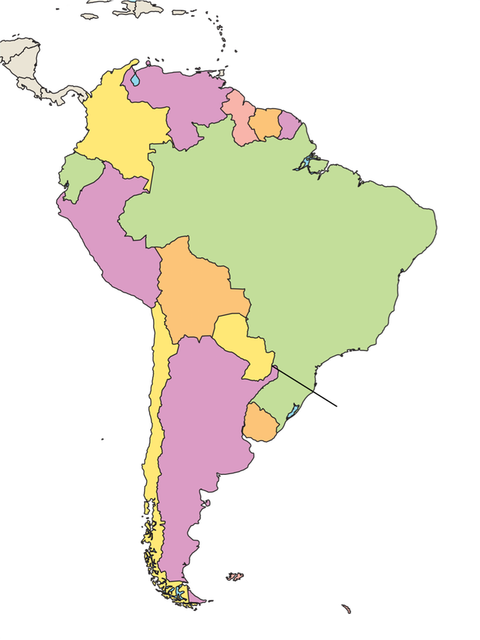Afterwalkingthroughthehotandhumidrainforest,Ihadfinallyreachedthelast,longfootbridge.JustaheadofmelaytheDevil’sThroat.Icouldhearitssteadyroar.ThecloserIgot,thelouderit became.
Iinchedforwardtotheedgeofthefootbridgeandpeeredoverthebalconytocatchsightofthismassivewaterfall.Mistfromthetumblingwaterroseintotheair.Iwasdrenchedwithin minutes.
Beforeme,thebulkofthemightyIguazúRiverplummetedoverthisrocky,U‑shapedcliffintoadeepandnarrowcanyon.Itwas breathtaking.
GreatWater
Liketheriverthatfeedsit,IguazúFallsgotitsnamefromtheindigenousGuaranípeople.Itsnamemeans“greatwater.”That’safittingdescriptionbecausetheamountofwatertherivercarriesoverthefallsis astounding.
Onaverage,theIguazúRiverflowsatarapidrate.Duringtherainyseason,it cancarrymorethanseventimesthatmuch.That’senoughwatertofillfiveOlympic-sizeswimmingpoolsa second!

Iguazú Falls
Atlantic
Ocean
Pacific
Ocean
Brazil
Paraguay
Argentina
South America
IguazúFallsisoneofthelargestwaterfallsystemsintheworld.ItstraddlestheborderofArgentinaandBrazilandisalmost2.7kilometers(1.7miles)wide.Duringtherainyseason,upto275differentwaterfallscanform.Inthedryseason,thereareonly 150.
Abouttwo-thirdsofthefallsareontheArgentiniansideoftheriver.IcrossedtheborderintoBrazil.Foragoodview,Iracedupthechurningriverinaspeedboat.Theboatslowedatthefootofseveralwaterfalls.Talkaboutapowerful shower!
It’shardtoappreciatehowspectacularsomethinglikethisisuntilyouhaveexperienceditforyourself.WhenEleanorRooseveltvisitedthefallsasfirstladyoftheUnitedStatesshesupposedlysaid,“PoorNiagara.”NiagaraFalls,whichliesbetweentheU.S.andCanada,isoneoftheworld’smoreimpressivewaterfallsystems.ButIguazúFallsisalmosttwiceastallandmorethantwiceas wide.
Asseenfromtheair,theDevil’sThroatdividesArgentinaand Brazil.

trailtoDevil’s Throat
Argentina
Brazil
Devil’s Throat
LegendoftheFalls
Likemanynaturalfeatures,theIguazúFallshasalegendthattellshowitcametobe.AccordingtotheGuaranítale,theserpentgodM’BoilivedintheIguazúRiver.M’Boiwasanangrygod.Eachyear,theGuaranípeoplemadeasacrificetokeephimfrombeingangry.Theythrewayoungwomanintothe water.
Oneyear,thetribechoseNaipi.Naipihadplannedtomarryawarriorfromanothertribe,namedTarobá.Thenightbeforeshewastobesacrificed,sheandTarobátriedtoescapeinacanoe.But,M’Boisawthem.Tarobápaddledashardashecould,buttheserpentgodwastoopowerful.Heslitheredandsquirmed,causingtherivertoformnew curves.
Thisslowedthepairdown.WhenTarobáwouldn’tgiveup,M’Boigotevenangrier.Hesplittheearth,creatingarockygorgeknownasDevil’s Throat.
NaipiwasthrowntoonesideofthegorgeandTarobátotheother.Aswaterflowedintothegorge,M’Boichangedtheyoungwomanintoarocksoshewouldn’tgetwashed away.
WhenTarobá triedtohelpher,M’Boipulledtheyoungwarrior’shandsintotheearth.Tarobá’sfingersturnedintoroots,andhisbodybecameapalmtree.Theyoungcouplewouldneverbetogetheragain.Butonsunnydays,thelegendsays,theymeetoverarainbowtoshowtheirloveforone another.
Arainbowbridgesthe falls.